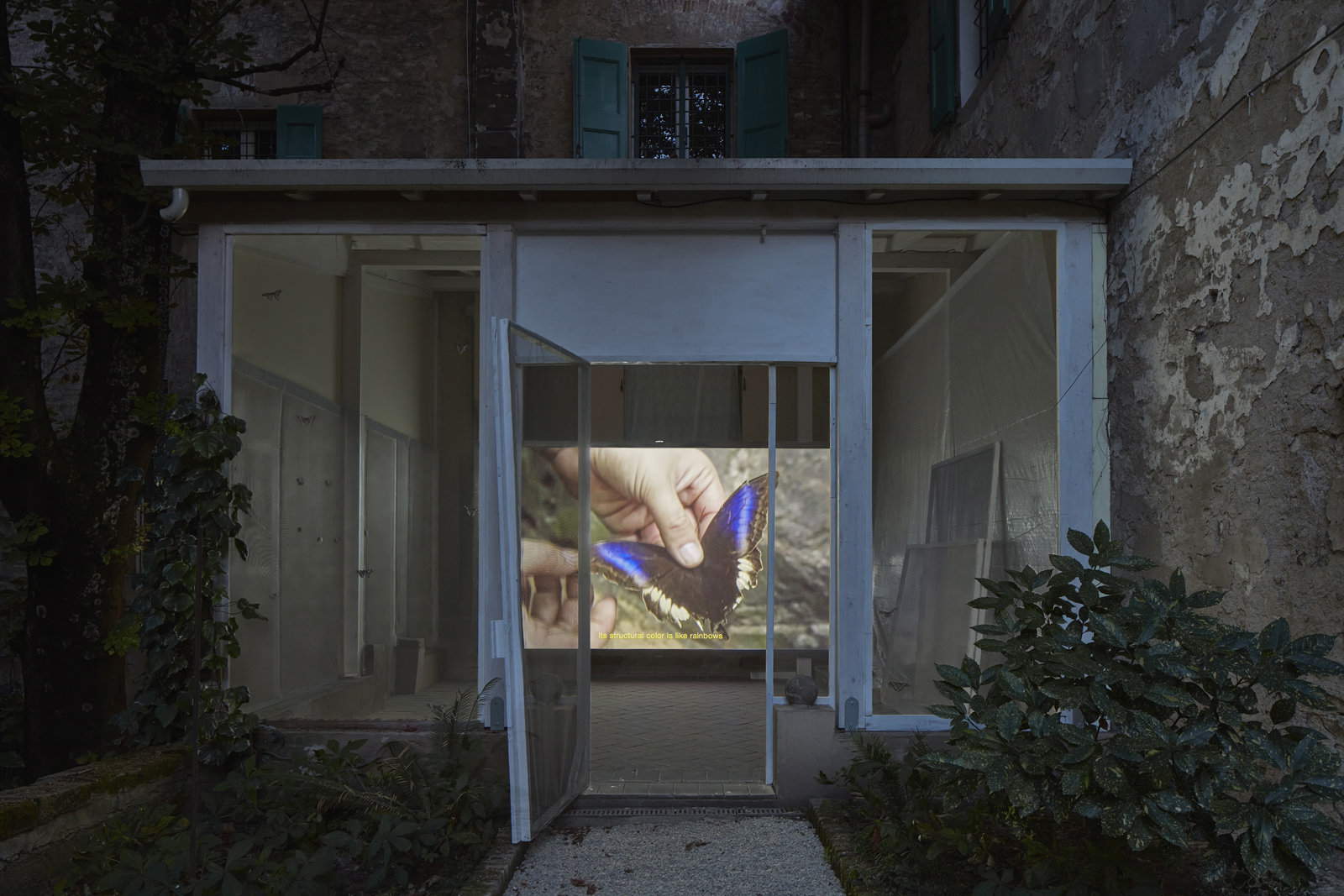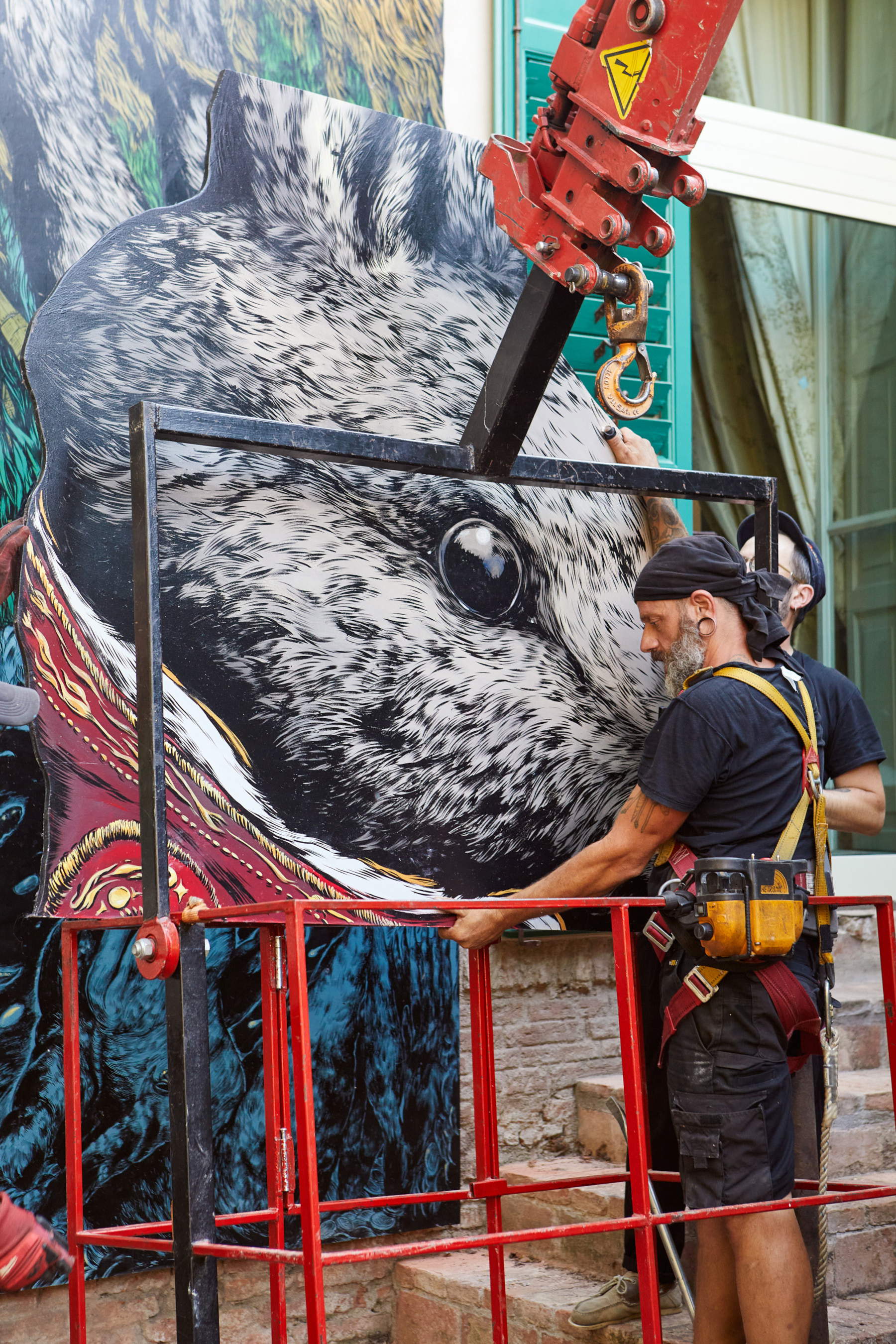In Bologna, June 11 kicks off a new chapter for the garden of Palazzo Bentivoglio, which returns to welcome the public with a double artistic intervention designed to dialogue with the space and suspended time of twilight. Until June 21, every Wednesday, Thursday, Friday, and Saturday, from 8 to 11 p.m., the garden will open its doors to host ΊΚΑΡΟΣ (Icarus), a 2020-21 film made by Giorgio Andreotta Calò, and to show for the first time in its entirety The Borgo Rabbit, a large mural work by Ericailcane.
The appointment is part of the line of research that Palazzo Bentivoglio has been undertaking for several years, dedicating the summer period to a project designed for its garden, with the aim of offering an alternative look at the relationship between contemporary art and the urban landscape. After the homage to John Giorno and Ugo Rondinone in 2023 and the performance ULTRAMORE by Riccardo Benassi the previous year, the 2025 edition focuses on a work that blends documentary dimensions, mythological narrative and naturalistic observation.

"The choice to present Ίκαρος (Icarus) in the newly acquired spaces of Palazzo Bentivoglio coincides with the transience of the place,“ the artist explains. ”Just as in the metamorphosis narrated in the film, the space is transformed into an expansion of the visual narrative, making the garden a metaphor for the logos where the story originates."
Giorgio Andreotta Calò’s 30-minute, 23-second film was shot in December 2020 inside a long-disused butterfly pavilion located in the Emmen Zoological Complex in the Netherlands. The structure, destined for demolition, is temporarily reactivated by the artist as a space for reflection and experimentation, in which a colony of moths settles. In this suspended atmosphere, between what remains of the pavilion’s original function and its imminent disappearance, two central figures move: Enzo Moretto, an experienced entomologist, and Bart Coppens, a young self-taught artist. Through the dialogue between the two protagonists, the film weaves a narrative that alternates moments of scientific observation with passages of an evocative nature, approaching the myth of Daedalus and Icarus. The relationship between master and pupil is charged with a symbolic tension that finds a correspondence in the life cycle of insects, whose metamorphosis becomes a visual and narrative metaphor. The moths, immobile during the day and active at night, embody the threshold between two states of being, that same threshold that the film proposes as a possible space for myth, where the real meets the vision.


The choice to screen the film in the evening hours is not accidental: the twilight setting creates an additional resonance with the themes discussed. While artificial light attracts insects and alters their behavior, darkness invites the viewer to enter a more rarefied perceptual dimension, in which the narrative becomes more ambiguous and evocative. The entomologist-Dedalus guides Icarus on a journey of knowledge in which the rational element coexists with risk, fascination, and the possibility of the fall. The film thus develops as a mythological theater in which every gesture, every flight and every stop of the moths can be read as part of a larger dramaturgy. Caló’s work challenges the separation between documentary and fiction, between real experience and symbolic representation, proposing a filmic device that includes the viewer in the process of transformation.
Alongside the screening of ΊΚΑΡΟΣ, the garden also hosts a permanent intervention by artist Ericailcane. The public will finally be able to view in full The Borgo Rabbit, a mural work that has been partially protruding beyond the boundary wall of Borgo di San Pietro Street for some time, arousing the curiosity of passersby and residents of the neighborhood. The work, 8 meters high and composed of five panels applied to the wall, is the result of a long dialogue between the artist and Palazzo Bentivoglio, and was created as a site-specific intervention designed to dialogue with the urban context and the surrounding nature. Ericailcane’s visual language, which has always been attentive to the animal dimension and its relationship with the human environment, fits coherently into this scenario. Its presence will be further explored through the publication of a book, due out in the coming months, which will recount its genesis, meaning and process. The exhibition runs from June 11 to 21, with evening opening from Wednesday to Saturday, 8 to 11 p.m. Participation is free, subject to availability.
 |
| Bologna, at the garden of Palazzo Bentivoglio the film ΊΚΑΡΟΣ by Andreotta Calò and the unpublished work of Ericailcane |
Warning: the translation into English of the original Italian article was created using automatic tools. We undertake to review all articles, but we do not guarantee the total absence of inaccuracies in the translation due to the program. You can find the original by clicking on the ITA button. If you find any mistake,please contact us.